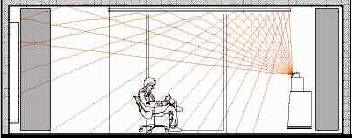|
GENERAL TIPS II
THE ENVIRONMENT
MAKES THE MUSIC.
By
Jorge Knirsch

Listening room acoustics
largely influences what
we hear. It may, sometimes, be responsible for more than half of the sonic
results we hear. It strongly influences tonal balance, soundstage and
dynamics. In the bass region, the acoustics of an untreated room is decisive
for listening and achieving the final results.
©
2004-2008 Jorge Bruno Fritz Knirsch
All rights reserved
http://www.byknirsch.com.br
●
Choose large
rooms
for sound
reproduction. Room volumes below 100m3 are considered small, giving way to many
problems with stationary waves.
Room
volumes above 200m3 are considered large environments, the best ones for sound
reproduction.
● Choose parallelepiped-shaped
rooms, “shoebox” type.
The three dimensions, length, height and depth, are very important, as well as
the relationships between them, that is, such dimensions shouldn’t either be
multiples between them or shouldn’t there be common factors between them. In
case you’re going to build a room, consult an acoustic engineer in order to
receive guidance on the best dimensions for the volume available.
● Avoid
square-shaped or concave walls or yet spherical or cubic room volumes in the
environment, by all means.
● Try to place
the loudspeakers along the least wide wall, and the listening spot
lengthwise.
● The free
volumes on both sides of an imaginary vertical plane passing between the
loudspeakers and the listener must be equal so that there is symmetry.
Symmetry is a precondition for better
soundstaging.
● This environment
or room for sound reproduction shouldn’t be either live or dead, but dry instead
and possessing a recommended reverb time below 1,0s over all the spectrum of
audible frequencies. In case your room is either live or dead, it will need
specific acoustic treatment.
Consult your
acoustician.
Live rooms in
general are good for acoustical recordings. Dry rooms are recommended for
listening to electronically-reproduced sound. The best listening room is the
Room for Critical Listening according to the proposal of norm
no. IEC60.268-13.
● Avoid the
excessive use of curtains, carpets, foams,
expanded polystyrene,
cushions,
etc., in
order not to change your room into a dead one with bass resonances.
● Place
loudspeakers between 1.0m and 1.5m away from back walls in small rooms (
100m3), and between 0.5m and 1.3m from side walls. In case you’d wish to know
the best position for your loudspeakers, consult an acoustic engineer, who may
determine the exact spot through calculations, based on your room’s length,
width and height, much reducing the standing waves problem.
● The best
position for the listener should be located on an equilateral triangle’s vertex,
where the other two vertexes are occupied by the loudspeakers. The listener
might stay up to one meter behind such position (now on an isosceles triangle’s
vertex) all the time within an imaginary vertical plane.
● The listener’s
ear must stay at the same height of the loudspeakers’ tweeters. Make
adjustments, either to the height of loudspeakers or yet to the listener seat’s
height.
● In general terms,
moving front loudspeakers away from the floor as well as moving them away from
back and side walls may reduce the bass.
● Adjust the
tonal balance of highs by applying toe-in to the front loudspeakers.
Check the loudspeaker manufacturer’s
recommendations.
● Have
the regular habit of listening to (unamplified) live music in order
to gain a better balanced musical perception and to be able to better adjust
your system.
●
The points mentioned above make up at least 50%
of your audio reproduction system’s sound results, regardless of its commercial
value.
● Avoid disclosing equipment
comparisons if your room is not treated and if your equipment is not of
reference quality.
In
order to make fit and fundamented comparisons, audiowise, your room should be a
Balanced Listening Room according to the proposal of norm
IEC 60.268-13.
I
wish the best listening and rooms with excellent acoustics to all.
The
environment makes the music!!!
Back
 -
PRODUCTS, PROJECTS AND INSTALLATIONS -
PRODUCTS, PROJECTS AND INSTALLATIONS
|